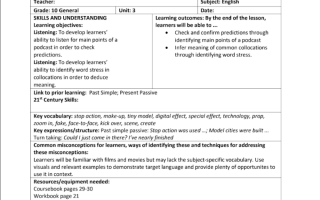حل الوحدة الثالثة انجليزي للصف العاشر عام فصل اول
Link to prior learning: Past Simple; Present Passive
21" Century Skills
Key vocabulary : stop action, make-up, tiny model, digital effect, special effect, technology, prop, zoom in, fake, face-to-face, kick over, scene, create
Key expressions/structure: Past simple passive: Stop action was used..., Model cities were built... Turn taking: Could I just come in there ? I've nearly finished
Common misconceptions for learners, ways of identifying these and techniques for addressing these misconceptions
Although the learners have already been introduced to the present passive, it can still be quite challenging for learners. In this lesson, learners will focus on common uses of the past passive. Provide plenty of examples and concept check regularly. Encourage learners to look at previous lessons to find other examples of the passive. Depending on the level and confidence of the learners, you may want to explain that to use the passive in other tenses the auxiliary verb (be) is changed. It may also be useful to explain to learners that a general rule of thumb is that information which the speaker/writer wants to highlight is presented at the beginning of the sentence (and sometimes at the end) and the passive is a technique used to bring that information to the front. Encourage learners to learn the expressions for interrupting as 'chunks of language. This is a good habit for them to have since most languages uses a range of fixed expressions and can seriously increase their communicative abilities
Resources/equipment needed
Coursebook page 30
Workbook page 22
Board Audio 6
UNIT 3 LESSON 2 TASKS/ACTIVITIES
Create a mind map on the board and write Special Effects in the centre. Invite learners to expand the mind map by adding different types of special effects. Elicit definitions. Discuss which special effects are used today and which are no longer used
Main activity
Use of English : Activity 6
. If necessary, refer learners to Unit 2 Lessons 5 & 6 to review passive
. Draw a table with 2 columns on the board and label the first column Active. Write the following sentence in the first column: John Logie Baird invented the TV
. Invite learners to identify the subject (John Logie Baird), the verb (invented), and the object (the TV
. Ask the following questions: Who invented the TV? (John Logie Baird);
What did John Logie Baird invent? (the TV); What is the most important fact in the sentence - Who invented the TV or what John Logie Baird invented (Who invented the TV). Explain to learners that, generally, in English the most important information comes at the beginning of the sentence
. Ask learners if they can change that sentence to make English the subject of the sentence (i.e. the most important fact
. Write Passive in the second column and invite learners to change the sentence into the passive (The TV was invented by John Logie Baird
. Read through the UOE box with the learners. Refer learners to Unit 7 Lessons 5 - 6 to remind them of past participle forms
. Play the audio. Learners write down four examples of the past simple passive
CORE
Feedback
Invite learners to write the example sentences on the board
Answers
a...stop action was used to make dinosaus
b A model of the monster was built
c Then the model was moved a little
d then the tiny models were painted
Differentiation Support
Allow learners to read the audio script as they listen
Differentiation Stretch
Learners change some of the active sentences in the audio into passive
Link to prior learning: There is/there are; Present Passive; Past Passive
21" Century Skills
Key vocabulary : video games, arguments for, arguments against, designers, audience, exhibition, graphics, museums, colourful, imagery, consider
Key expressions/structure : Impersonal constructions: It is thought that..., Some people suggest that
Common misconceptions for learners, ways of identifying these and techniques for addressing these misconceptions
Learners may struggle to put the paragraphs in the correct order. As a dass, map out the essay using the sequencing words such as the Second: Against; Third: For. Using the title, ask learners what a pro argument would be (video games are art) and a con argument (video games are not art). Explain to learners that they should use these as a guide for reading through the essay and putting the paragraphs in the correct order
Impersonal constructions can be difficult to understand and identify. For this lesson learners are exposed to the language structure and its explanation for use Highlight that it is often used in formal writing. In the next lesson learners will be able to practice the use of the structure. So, for now its advised that learners have a good understanding of its purpose. This language structure uses the passive so it may be useful to quickly review the previous lesson and Unit 9 Lessons 3 & 4
Resources/equipment needed
Course book page 31-32
Workbook page
Dictionaries UNIT 3 LESSON 3 TASKS/ACTIVITIES
Starter
Using the bullet point questions conduct a discussion around video games which ones learners like to play and why. Try to draw out key vocabulary when learners explain their reasons for playing particular video games
Main activity / Resources
Reading : Activity 1
Coursebook page 31
. Following on from the starter, elicit from learners which games use a lot of imagery and colour and those that do not
. Elicit from learners if using colour and imagery makes a game more appealing and why
. Have learners look at the two pictures and identify the differences and similarities
. Learners complete activity
Link to prior learning: Unit 4 Lessons 9 & 10
21st Century Skills
Key vocabulary : light, dark, bright, shade(s) of colour, pale (sky blue, mint green, olive green, lavender blue
Key expressions/structure: Pre-modifiers in noun phrases: a clear blue sky
Common misconceptions for learners, ways of identifying these and techniques for addressing these misconceptions
Learners may ask question that relate to the following points. Pre - modifiers can be nouns or adjectives. Pre-modifiers in noun phrases can contain more than two words but keep examples short to avoid confusion. Nouns that modify nouns are classified as nouns even though they are functioning in a similar way to adjectives. When two nouns are often used together they might be separated by a hyphen. Use a dictionary to check. Noun + noun examples are often referred to as compound nouns (these will be looked at in a later unit), with the first noun identifying a particular type in relation to the group of people or things described by the second noun. Also, learners who use nouns to modify other nouns may try to make the first noun plural. Finally, the focus for this language point is on expanding the main noun, so don't place too much emphasis on distinguishing between nouns and adjectives as pre- modifiers
Resources/equipment needed
Coursebook page 33 - 34
Workbook page 25
Board Audio 7 UNIT 3 LESSON 5 TASKS/ACTIVITIES
Resources Starter
Guess the noun. Write a selection of nouns on the board and choose one to describe to the class without saying what it is. For example, if you say table, you can describe it as big, round, you use it to sit at. Learners guess the noun before playing in groups




